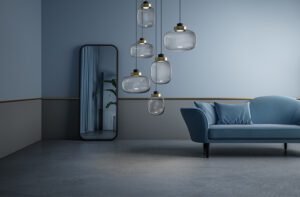Dee Elms Designs a Boston Penthouse
November 6, 2024
Working with original elements in a nineteenth-century penthouse, a design team infuses the home with color and cohesion.
Text by Erika Ayn Finch Photography by Michael J. Lee
Nearly 200 years after being built, the penthouse at the crest of Boston’s Beacon Hill understands the inevitability of change. For a time, it housed a theology school. A prominent art dealer called it home for many years. Somewhere along the way, it merged with the unit next door to become one light-filled space. Most recently, its interiors exuded a traditional vibe.
But when interior designer Dee Elms’s new client, a longtime acquaintance, asked her to tour the space with him before he signed on the dotted line, she immediately recognized that it was the layout and light that made it truly exceptional. All it needed was, well, some changes.
Mixing Modern Design with Historic Features
The well-traveled homeowner wanted something comfortable but current. “He’s great at not overthinking things,” says Elms, “which made it easy to do our job.” A deep dive into his personal aesthetic revealed a penchant for saturated colors like aubergine, teal, and green, which appear perhaps most prominently in the completely remodeled kitchen (he actually pushed for the teal pony-fur bar stools) and in the office and dining room. It’s the long, narrow office, with its views of the Charles River, that enthuses Ryan Garrity, vice president of Sea-Dar Construction, the most.
“The combination of the walnut millwork, Venetian-plaster ceiling, and high-gloss walls, which required an extensive amount of work to achieve, is the only thing that could match the view,” says Garrity.
On the flip side, the homeowner told the team he didn’t want a complete gut renovation. “That was a challenge because instead of working with a blank slate, we had to be very creative, especially given the unique nature of renovating in Beacon Hill,” recalls Garrity, who has a longstanding relationship with the homeowner.
Balancing History and Modernity
One of the elements that required some creativity was the home’s wide fire door, which originally separated the two units. Elms, however, saw an opportunity and instead flanked the door’s dining room side with a much-needed coat closet and a monochromatic sterling-silver-hued bar. Both are tucked behind suede-upholstered doors. Walk through the fire door and you find yourself in a family room with a comfy B&B Italia sectional.
Elms got creative with some of the home’s other original elements, including the brick-lined hallway that connects the kitchen and hang-out space (where the homeowner gathers with his adult children to play poker and, yes, build a LEGO model of the Titanic). She reached out to decorative painter Pauline Curtiss to cover the hallway’s barrel-vaulted ceiling in a graffiti pattern that highlights the home’s colors, including fun pops of chartreuse.
In the living room, Elms elected to emphasize the striking arched windows by forgoing treatments, and in the primary bath, she chose to clad the portal that leads from the vanities to the bathing area with three-quarter-inch steel, making two separate spaces feel cohesive.
Garrity looks back on the project as an exemplary example of bringing modernity to a historic home without completely starting over, and he’s quick to credit the craftspeople who came together to make it all happen so quickly. Elms adds the homeowner to that list. “We love what we do, and when we partner with people who appreciate it and are willing to try new things, I think it results in our best work,” she says. It’s not a stretch to imagine that if walls could talk, the penthouse would agree.
Project team
Interior design: Elms Interior Design
Builder: Sea-Dar Construction
Share
![NEH-Logo_Black[1] NEH-Logo_Black[1]](https://b2915716.smushcdn.com/2915716/wp-content/uploads/2022/08/NEH-Logo_Black1-300x162.jpg?lossy=1&strip=1&webp=1)

























You must be logged in to post a comment.